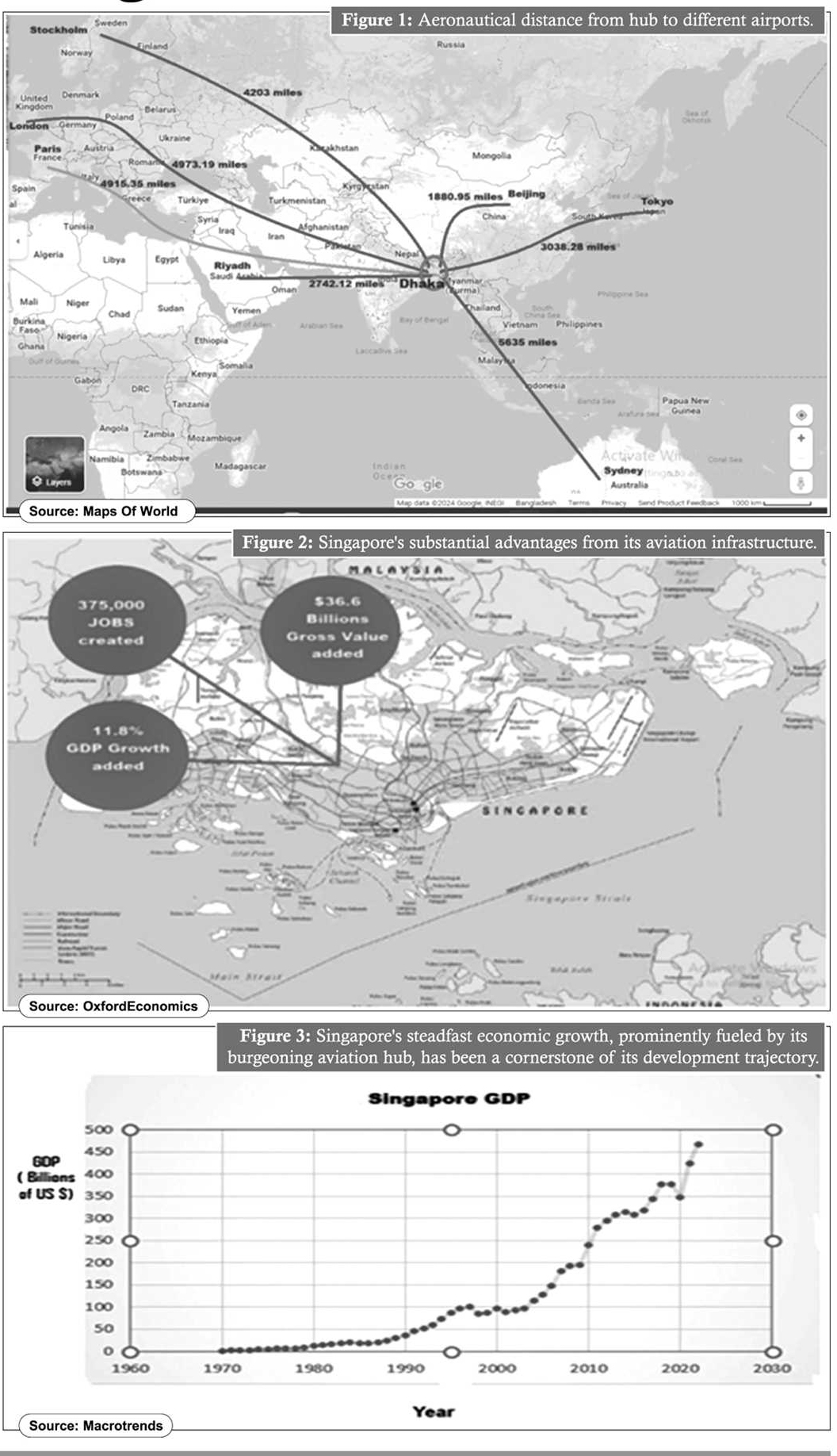
Can Bangladesh emerge as an aviation hub?
Asheka Moztoba Esha and Samiha Tasnim Hridi | Saturday, 29 June 2024
An airline hub, often known as a hub airport, is a facility that one or more airlines utilise to consolidate passenger traffic and flights. Hubs function as transfer (or stop-over) sites to enable travelers to get to their final destination. Bangladesh's chances of becoming a regional aviation hub would improve with the full operation of the newly built Terminal 3, which features a multi-level parking facility capable of holding up to 1,230 vehicles at a time. Furthermore, it is linked to the country's first elevated expressway and a network of roads connecting it to the nearby Dhaka-Mymensingh highway. Several international airlines have already shown interest in running flights to and from Dhaka, which will boost the nation's economic growth.
Terminal 3 has the potential to serve as a pivotal airline hub in the future, given its cost advantages over countries like Singapore and the UAE which offer transit services. With busy airports in these regions often experiencing flight delays due to traffic congestion, Terminal 3's affordability could outweigh concerns about potential delays for international passengers.
During a recent two-day bilateral discussion, the Civil Aviation Authority of Bangladesh (CAAB) rejected a request from carriers of the United Arab Emirates (UAE) for fifth freedom rights. These rights permit an airline to carry passengers from its home country to a second country and then onward to a third country. The first two freedoms pertain to the transit of commercial aircraft over foreign airspace and airports, while the remaining freedoms involve the international transport of people, mail, and goods. Would the granting of fifth freedom rights have positively impacted the economy of Bangladesh? This can be a matter of discussion.

Terminal 3 can act as a connector between many countries such as Australia, the United Kingdom, China, and many more. However, if we look into another hub airport such as Dubai Terminal 3, considering a flight from London to Sydney via Dubai, the total distance is around 9500 nautical miles. If Dhaka Terminal 3 connects the flight, if we consider Figure 1, the total distance will be around 9000 nautical miles, which will reduce the flying time. By functioning as a hub, Dhaka Terminal 3 has the potential to mitigate flight delays. In addition, stoppage in Dhaka Terminal 3 can also decrease ticketing prices in contrast to Dubai Terminal 3. Emirates and Qatar Airways are implementing the hub model connecting Asia with Africa, North and South America with Asia, and others via Dubai and Doha respectively. Dhaka Terminal 3 can be part of this model if it becomes a hub.
In Bangladesh, crisis of foreign exchange is persistent, mitigated largely by remittance and the export of readymade garment goods, due to the absence of any solid alternative sources. In such a scenario, aviation hubs can incorporate foreign currencies as well. If international airlines are allowed to decelerate in Bangaldesh's airport, it could be a good deal to bring forex in addition to a global transit creating massive job opportunities for our manpower. Utilising international travels presents an excellent opportunity for accruing additional foreign currencies. Every air interval will create opportunities for the traveler to roam in Bangladesh's airports, food lounges, exotic airport shops and the city where passengers can shop and contribute to our economy. Along with Dhaka if the authority focuses on other potential spots like Cox's Bazar Airport, Shah Amanat Intl Airport (Chittagong), Osmani Intl Airport (Sylhet)t and approach Saidpur Airport for the aviation hub purpose, these spots can boost our economic activities including trade, tourism and industry. Offering aviation fuel to international airlines at local rates and incorporating discounted landing fees present a mutually beneficial opportunity for both domestic entities and airline conglomerates.
The existing two terminals in Dhaks can handle 80 million passengers a year. With the introduction of Terminal 3, the number will increase by another 20 million. Cargo handling capacity is also expected to increase three times. However, to establish Bangladesh as a significant aviation hub necessitates more than the launching of Terminal 3 and additional runways; it demands meticulous strategic planning and prolonged endeavours. Bangladesh faces hurdles in strategic planning, lacking a clear expansion strategy hindering hub potential. Insufficient infrastructure and resources impede growth.
An aviation hub essentially denotes enhanced air connectivity, leading to a potential surge in both domestic and international air traffic, thereby generating significant revenue. Transforming a city into an aviation hub requires meticulous planning and technological advancements. Access to the city should be facilitated by expressways to ensure swift travel, coupled with top-tier security measures. Additionally, a well-equipped cargo village is imperative. The airport infrastructure should feature upscale domestic outlets and products, enabling the country to effectively brand itself in the market. Passenger comfort can be further enhanced by integrating five-star hotel amenities.The complex should showcase local yet globally competitive products. Besides, Bangladesh should adopt an open sky policy similar to Dubai, Singapore, Bangkok, and Kuala Lumpur, where all airlines can operate without restrictions. Additionally, Bangladesh needs to address its infrastructure challenges likewise according to the Airbus Global Market Forecast study, by 2042, Bangladesh needs 105 narrow-body and 55 wide-body planes to meet rising air travel demand.
Given Singapore and Dubai's rapid transformation into global aviation hubs despite their small populations, why can't Bangladesh, with its abundant and youthful workforce, strategic location in East, Southeast, and South Asia, achieve similar status? Experts propose that with a well-formulated strategic plan and substantial investment, Bangladesh could become an aviation hub within five years.
Asheka Moztoba Esha and Samiha Tasnim Hridi are undergraduate students at the Department of Economics and Social Sciences, Brac University.asheka.moztoba.esha@g.bracu.ac.bd, samiha.tasnim.hridi@g.bracu.ac.bd.